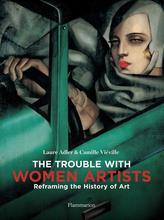More about Sofonisba Anguissola
- All
- Info
- Shop

Contributor
Sofonisba Anguissola made it farther in the art world than any woman had before her. Yay for feminist anomalies in the Renaissance Era!
Born in 1535-ish in Cremona, Italy, Sofonisba was the daughter of Amilcare Anguissola, a man who actually taught his six daughters something other than table manners and passiveness. He taught them to paint and Sofonisba was by far the best of her siblings. She was so talented in fact that Amilcare sent his daughter’s paintings to Pope Julius III and they somehow got into the hands of the legendary Michelangelo. He loved her work depicting a girl laughing, but then challenged her to paint the opposite emotion. Sofonisba replied by depicting a boy whose finger was pinched by a crawfish, a painting which Michelangelo applauded. He unofficially took her on as a student. He couldn’t officially do so because though she was talented, she was still a woman. Her education was supposed to be about being a better wife and mother. Classic patriarchal agenda getting in the way of women’s lives…
Sofonisba still milked her talent for all it could give her and ended up as a lady-in-waiting to the new queen of the Spanish court, Elisabeth of Valois who was 14 and an aspiring painter. Sofonisba and Elizabeth became BFFs and she taught her how to paint until Elizabeth’s death during childbirth 10 years later. After that the king of the Spanish Court gave her what he thought was the greatest gift ever: a husband. Sofonisba was like, “Gee thx” and got married. Her husband died eight years later and two years after that, she fell in love with a sea captain. There were no other fish in the sea for them and they stayed together until Sofonisba’s death in 1625.
Though she was incredibly popular at the time, and even counselled young Anthony van Dyck, it wasn’t until the 1970s, when feminist art historians were going back and giving credit to women who had been swept under the rug by the patriarchal broom, that Sofonisba was recognized as a great Renaissance painter. It only took, like, 350 years but better late than never, right?
Sources
- Morris, Roderick. "Acknowledging, Finally, The Work Of Women Artists." Nytimes.com. N.p., 2008. Web. 11 July 2017.
Featured Content
Here is what Wikipedia says about Sofonisba Anguissola

Sofonisba Anguissola (also Sophonisba Angussola or Anguisciola; c. 1532 – 16 November 1625) was an Italian Renaissance painter born in Cremona to a relatively poor noble family. She received a well-rounded education that included the fine arts, and her apprenticeship with local painters set a precedent for women to be accepted as students of art. As a young woman, Anguissola traveled to Rome where she was introduced to Michelangelo, who immediately recognized her talent, and to Milan, where she painted Fernando Álvarez de Toledo, 3rd Duke of Alba. The Spanish queen, Elizabeth of Valois, was a keen amateur painter and in 1559 Anguissola was recruited to go to Madrid as her tutor, with the rank of lady-in-waiting. She later became an official court painter to the king, Philip II, and adapted her style to the more formal requirements of official portraits for the Spanish court. After the Queen's death, Philip helped arrange an aristocratic marriage for her. She moved to Sicily, and later Pisa and Genoa, where she continued to practice as a leading portrait painter.
Her most distinctive and attractive paintings are her portraits of herself and her family, which she painted before she moved to the Spanish court. In particular, her depictions of children were fresh and closely observed. At the Spanish court she painted formal state portraits in the prevailing official style, as one of the first, and most successful, of the relatively few female court painters. Later in her life she also painted religious subjects, although many of her religious paintings have been lost. In 1625, she died at age 93 in Palermo.
Anguissola's example, as much as her oeuvre, had a lasting influence on subsequent generations of artists, and her great success opened the way for larger numbers of women to pursue serious careers as artists. Her paintings can be seen at galleries in Boston (Isabella Stewart Gardner Museum), Milwaukee (Milwaukee Art Museum), Bergamo, Brescia, Budapest, Madrid (Museo del Prado), Naples, and Siena, and at the Uffizi Gallery in Florence.
Her contemporary Giorgio Vasari wrote that Anguissola "has shown greater application and better grace than any other woman of our age in her endeavors at drawing; she has thus succeeded not only in drawing, coloring and painting from nature, and copying excellently from others, but by herself has created rare and very beautiful paintings."
Check out the full Wikipedia article about Sofonisba Anguissola



















